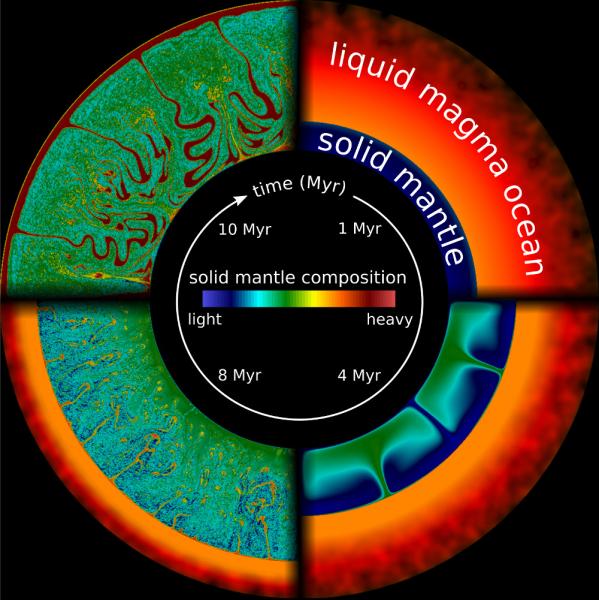Solid state convection and mixing of the Martian mantle before complete solidification of its magmatic ocean
An international team of researchers including an IRAP researcher (Paul Sabatier University of Toulouse and CNRS) publishes the results of a study devoted to the early thermo-chemical evolution of the Martian mantle. The picture resulting from the numerical simulations carried out within this study was selected for the cover page of the March 2017 edition of the Journal of Geophysical Research: Planets, an American Geophysical Union (AGU) journal.

Early in their history, the telluric planets probably had much, if not all, of their rocky mantle melted due to the large amounts of heat released during their formation. These magmatic oceans of molten rock were able to solidify within a few thousand years. This solidification leads to a mantle that is chemically stratified with light material at depth and heavier material (because it is enriched with iron) near the surface. Previous studies have shown that this unstable gravitational configuration causes an overall reversal, leading to a stable layered configuration. This can prevent deeper movements of the rocky interior (solid-state convection).
Yet, in the case of Mars, the presence of large volcanic provinces, with evidence of recent volcanism, suggests a long-lasting internal dynamic of its mantle, a scenario difficult to reconcile with that of a stably stratified and immobile mantle.
The solidification of a magmatic ocean may also be accompanied by the formation of a thick insulating atmospheric blanket of water and carbon dioxide. This slows down the cooling of the molten mantle considerably because it allows a high surface temperature to be maintained for several million years as a result of the greenhouse effect. Our numerical simulations show that for a slowly cooling magmatic ocean, convection can develop in a slowly solidifying heterogeneous mantle and begin to mix it as the overlying magmatic ocean continues to solidify (Figure). Contrary to the traditional scenario, no highly unstable configuration is reached at the end of the magmatic ocean stage. On the contrary, the resulting planet has a partially homogeneous mantle that is weaker in density stratification, allowing it to maintain convection in the long term, in agreement with observations.
Further Resource
- Article : Onset of solid-state mantle convection and mixing during magma ocean solidification, by M. Maurice et al. Maurice_etal_2017.pdf 1.80 MB
IRAP Contact
- Henri Samuel, henri.samuel@irap.omp.eu






